This regular monitoring of the food security situation in Ukraine and wartime agricultural policy response is provided by the Center for Food Research and Land Use KSE Institute in cooperation with the Ministry of Agrarian Policy and Food of Ukraine. It shall assist various stakeholders and interested parties in taking decisions based on facts and evidence.
Global view: Russia’s invasion of Ukraine amplified the role of Ukraine in ensuring global food security. Blocked exports and endangered current planting campaign in Ukraine surged world market prices and risked not only to undermine the country’s agri-food sector and overall economy, but also to starve hundreds of millions globally. Ukraine has been playing an increasing role on the world agricultural market. Only two decades ago Ukraine’s grain exports were equivalent to feeding 40 mln people, and already more than 400 mln today. In 2019-2021 Ukraine accounted for nearly 10% of global wheat and 15% of corn exports, 15% of barley exports and nearly 50% of sunflower oil exports.
Domestic view: Locally, agriculture accounts for about 20% of GDP (if upper- and downstream sectors are accounted for) and for more than 40% of total export reveneues. Aside from being an imporant sector in terms of GDP and employment (around 15% of the total population of Ukraine5 ), agricultural producers provide the local population with nearly 100% of its staple crops, vegetables and at least 80% of meat consumption5 . Despite Ukraine’s vast agricultural production potential, the war does not only severely impact the global food security, but the domestic food security as well.
Food Security and Agricultural Policy Review in Ukraine
Food Security and Agricultural Policy Review in Ukraine. October 18, 2022
The full review
Food Security and Agricultural Policy Review in Ukraine. September 2, 2022
The full review
Food Security and Agricultural Policy Review in Ukraine. August 12, 2022
The full review
Food Security and Agricultural Policy Review in Ukraine. July 26, 2022
By the end of June, The Food affordability index (FAI) dropped even further to 6.5, which is 47.6% lower than before the war, 12% lower than in the first half of June, and 14.9% lower than in May. Before the invasion, the FAI was 12.4. It implies that the person with an average income at the end of June could buy almost 48% less food compared with the pre-invasion level.
This is stated in the Food Security and Agricultural Policy Review – the regular monitoring of the food security situation in Ukraine and wartime agricultural policy provided by the Center for Food Research and Land Use KSE Institute (KSE Agrocenter) in cooperation with the Ministry of Agrarian Policy and Food of Ukraine.
The main reason for the worsening of FAI is the increase in the average price for the “basket of goods”. As of the last week of June (June 27 – July 1), the price of the food basket is 17.5% higher compared to the May 23-27 price. Such a dramatic increase in prices is mainly explained by seasonality. Early vegetables of the new harvest, which are much more expensive than the previous year’s harvest, started to appear in stores, leading to the increase in prices for onions (+26%), potatoes (+190%), beetroot (+51%), and carrot (+29%) as of the June 27 – July 1, compared to June 23-27.

The Russian occupation of regions where a substantial share of vegetables were produced has made this increase even more significant. The seasonal growth was increased due to the occupation of the Kherson region, which is among the leading regions in vegetable production in Ukraine. The prices continue to grow because of supply chain disruption, logistics complications, and increased production costs.
Approximately 19% of all vegetables in 2021 were produced in now-occupied territories, with this share being even higher for some vegetables – 21% for cucumbers, 31% for pepper and 32% for tomatoes.
The highest price increase is observed in Khmelnytskyi and Odesa regions: in the last week of June (June 27-June 1), compared to May 23-May 27, prices went up by 22,6% and 21%, respectively.
On June 13-17, compared to May 23-27, the highest price growth was observed for buckwheat (+16%), chicken eggs (+27%), cabbage (+21%), and onions (+14%). Commodities that experienced price decreases at the national level over this period include beef (-3%), sour cream, and butter (both -1%). On June 27 – July 1, compared to June 13-17, high price growth was observed for eggs (+25%), while there was a decrease in prices for flour (-2%), millet (-5%), and beef (-1%).
However, the team of KSE Institute’s Center for Food and Land Use Research (KSE Agrocenter), stated that at the beginning of July, positive trends in price reduction have already become noticeable.
«The prices for vegetables, which increased significantly in June, began to decrease at the beginning of July. As a result, the Food Affordability Index improved as well», – Hryhorii Stolnikovych, expert of KSE Agrocenter.
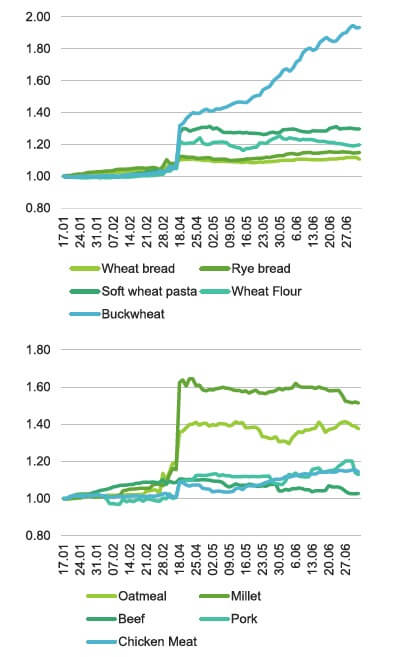
Food affordability – marginal improvement at a national level
By the end of June, as compared to the period of May 23-27, the most significant increase in the average number of assortments of food commodities available within one commodity group was observed in Rivne (+9.4%), Dnipro(+9.5%) and Chernihiv (+8.4%) regions.
The situation in Bakhmut – a city mere miles from the frontline, which was already challenging in May, did not improve throughout June. As of June 21, the average number of assortments of food products available within one product group decreased by 16,1%, as compared to May 23-27. After June 21 no data for Bakmut is available. The reason for this is the active military actions moving closer to the city and Bakhmut being one of the directions for the further RF’s offense.
Two more cities where a significant decrease in assortment was observed, are Ivano-Frankivsk (-11.4%) and Poltava (-12.2%). In other cities, no significant change was observed in June.
As of July 1, compared to May 29, availability of cabbage increased by 30.5% due to the arrival of new harvest to the stores. Also, the is an increase in the availability of millet (+14.1%) and white sugar (+13.2%). On the other hand, the availability of beetroot suffered the most significant decrease (-17.5%) due to decreased production this year – Kherson region, which is leading in beetroot production in Ukraine, is partially occupied. Beef availability, which was low in the previous periods, improved by 6%. For other categories of products, no significant changes have been observed.
Graphs below demonstrate daily changes in the number of product assortment available in Ukraine.
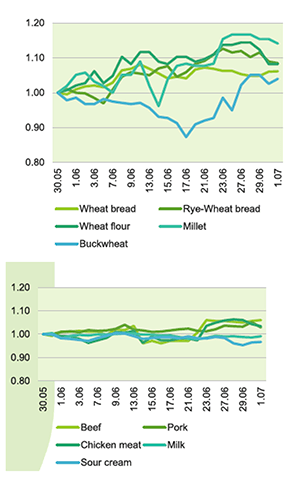
Agri & Land policy improving registers legislation
On June 21, amendments were made to the resolutions of the Cabinet of Ministers about registers, the holder of which is the Ministry of Agrarian Policy and Food of Ukraine. Changes affected the legislation on registries – including the registry of seed-growing entities, agronomists-inspectors registry, conformity assessment bodies registry, certificates for seeds/planting material registry, and the agrarian registry. Main changes included:
– Transfer of registries from paper to online format and creation of electronic user cabinets in order to minimize paperwork and facilitate the use of the registers.
– Assign the functions of the administrator of the registries to the state enterprise “Agrarian Registries”, which will be responsible for the deployment of the mentioned Registries.
On June 24, the procedure for using the funds provided by the state budget to support farms and other producers of agricultural products was approved.
The full review
Food Security and Agricultural Policy Review in Ukraine. July 20, 2022
The full review
Food Security and Agricultural Policy Review in Ukraine. June 22, 2022
Despite the fact that as of mid-May, the food availability index (FAI) is 1.3% higher than at the end of April, it is 37% lower than the pre-war level. Before the invasion, the FAI was 12.4. So, a person with an average salary could buy a number of “baskets of goods” equivalent to a stock for 12.4 months. The current FAI is only 7.8. Thus, we continue to observe significantly reduced purchasing power relative to the main food products of the Ukrainian consumer.
Significantly higher prices and declining product range currently characterize the food market in Ukraine. In May the value of “basket of goods” is 4.4% higher than at the end of February, and the range of products in the Donetsk region is the lowest compared to other regions of Ukraine. This is stated in the Food Security and Agricultural Policy Review – the regular monitoring of the food security situation in Ukraine and wartime agricultural policy provided by the Center for Food Research and Land Use KSE Institute in cooperation with the Ministry of Agrarian Policy and Food of Ukraine.

“In 2019-2021 Ukraine accounted for nearly 10% of global wheat and 15% of corn exports, 15% of barley exports and nearly 50% of sunflower oil exports. RF’s invasion of Ukraine has demonstrated the role of Ukraine in ensuring global food security,” said experts of the KSE Institute’s Center for Food and Land Use Research. “Blocked exports, reduced acreage of arable land and threatened harvest campaign are keeping world prices high, creating the risk not only to undermine the country’s agri-food sector and overall economy, but also to starve hundreds of millions globally.” The review shall assist various stakeholders and interested parties in taking decisions based on facts and evidence.
FOOD AFFORDABILITY INDEX
The average price for the “basket of goods” in Ukraine went down by 1.3% for the week spanning May 9-May 13 as compared to April 18-April 22. Only one-third of the products in our basket increased in price, while two-thirds became cheaper. Still, the price of our basket is 4.4% higher compared to the week prior to the RF invasion, February 21-February 25.
Compared to the previous period of observation, the most significant drop in the price of the goods basket is for the temporary occupied Kherson oblast: the basket’s price there went 10.7% down in less than a month. Nonetheless, Kherson oblast experienced the highest price increase since the beginning of the war. The price of our basket in this region is still 21.5% higher compared to February 21-February 25. The next two regions with the highest price increase for our basket are Chernihiv and Zaporizhzhia. The Chernihiv region was liberated from RF’s invaders in late March. As of May 9-May 13, the basket’s price there jumped up by 9.1% since the beginning of the war. Zaporizhzhia region is currently partially occupied and has experienced an 8.3% price jump for the same period. There is no information available for another two regions occupied by the RF’s army – Donetsk and Luhansk regions.
Average salaries before and after the invasion, as well as the price of the basket of food products, allow for estimating the FAI – Food Affordability Index. FAI is estimated as a ratio of the average salary to the price of the basked of food products.
Before the invasion, the FAI score was 12.4, implying that the person with an average salary could buy 12.4 months’ worth of food products from our basket. The current FAI score is 7.8. Although the score is 1.3% higher than the FAI score estimated for late April, it is still 37% lower than the pre-war level. Thus, we continue witnessing decreased purchasing power (in April 18-April 22, it was 37.9%) for essential food products of an average Ukrainian consumer.
DOMESTIC FOOD PRICES
Commodities with prices decreased at the national level on 9-13 May compared to 18-22 April include wheat and rye bread, wheat flour, millet, chicken meat, milk, chicken eggs, butter, white sugar, onion, and potato. Food items with prices increased at the national level are carrots, beetroots, cabbage, sunflower oil, pork and buckwheat.
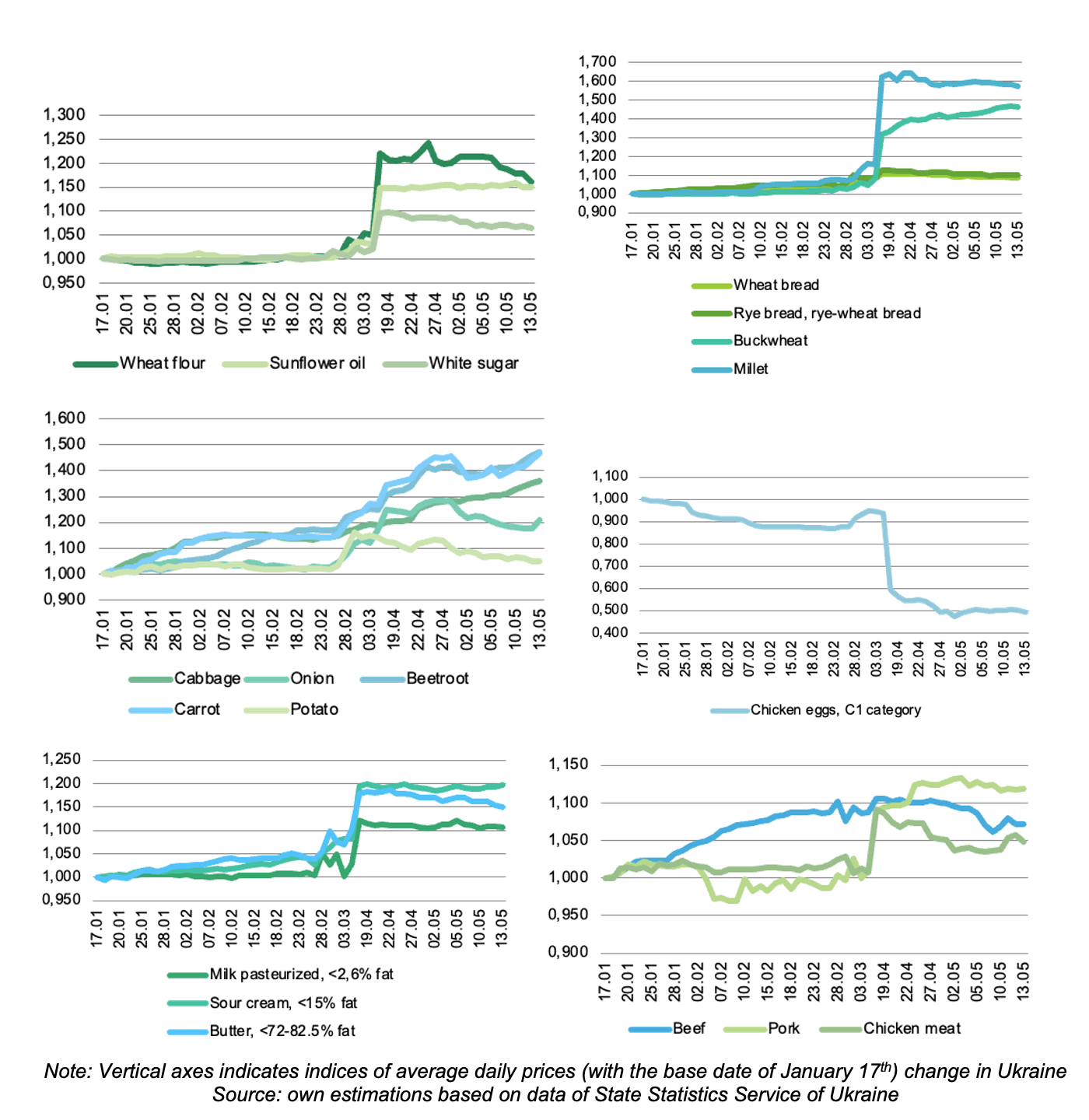
FOOD AVAILABLITY. DONETSK REGION AT HIGH RISK
As of May 13, there are problems with the availability of beef at the national level. Only 0-2 unique positions of beef are available in 15 cities. Pork and chicken meat have rather good representation: 17 and 11 unique positions, respectively, are available on average in these cities and country-wide.
The smallest average quantity of food items available within one commodity group is found in Bakhmut city (Donetsk region) – 3.26. This is 4 times lower than the country’s average. Besides that, there are no meat and bread available in stock. This does not explicitly imply a complete deficit of such products in a region but rather signalizes strong dependency on regular supplies of commodities with short shelf-life and general supply complications. Active battles taking place in very close proximity to this city is the major reason for this.
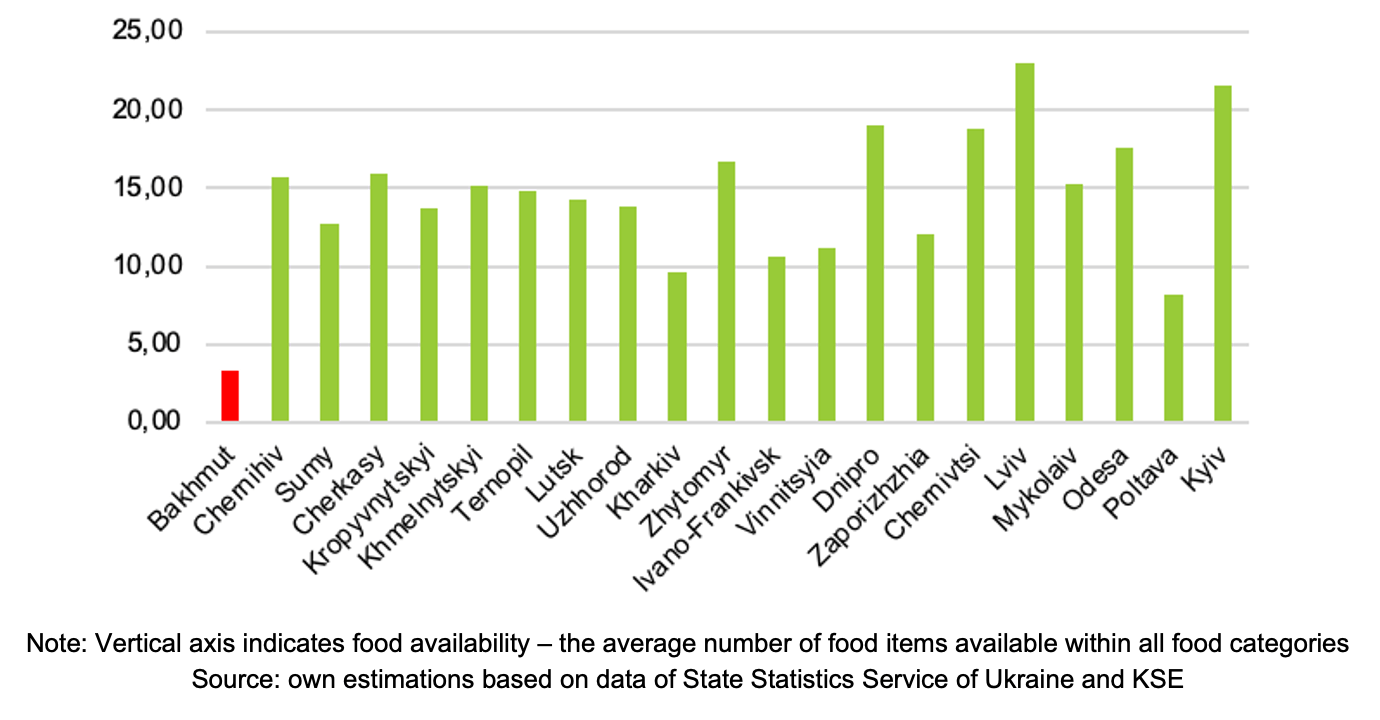
The full review
Food Security and Agricultural Policy Review in Ukraine. May 17, 2022
Food security is a complex phenomenon that is generally composed of three elements: food availability, access and utilization.
Before Russia’s invasion, the Food Affordability Index (FAI) score in Ukraine was 12.4, implying that the person with an average salary could buy 12.4 months’ worth of food products from our basket. The current FAI score is 7.7, implying 37.9% reduction in purchasing power of an average consumer in Ukraine, thus signaling about a substantial decrease in food access for Ukraine’s population.
Russia’s invasion of Ukraine surged substantially the prices of the main food commodities in Ukraine and its regions. The absolute champions in a price race were: Kherson oblast with 29.6% growth, while Cherkasy, Mykolaiv, Sumy and Ternopil oblasts have grown by 13.1-10.3%. Overall in Ukraine, prices for bread, flour, meat, dairy, milk and vegetables increased by 5.6-34.5% depending on the product.
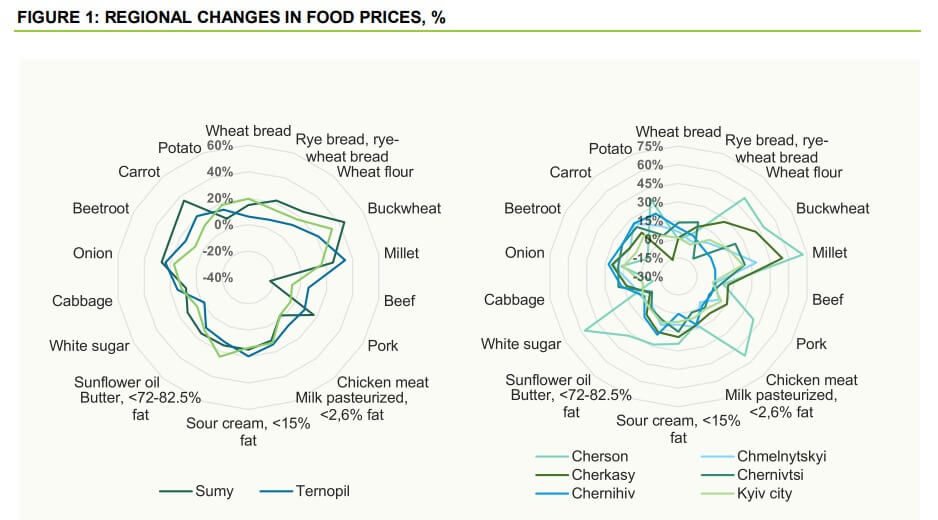
There are important changes introduced into the agrifood policy of Ukraine as a response to the problems originated from the Russia’s invasion. They are valid for the wartime period and apply to small and medium-sized agricultural producers with a turnover of no more than 20 million euros per year, which is the equivalent of an enterprise that cultivates up to 10,000 hectares. In particular: a) all enterprises with annual turnover less than 10 bln UAH (340 mil USD) are eligible for a 2% turnover tax and excepting from VAT and profit taxes; b) excise tax on fuel is removed and VAT reduced from 20% to 7%.
METHODOLOGY
Food Affordability Index (FAI) is estimated as a ratio of the average salary to the price of the basket of food products. The FAI is calculated using the regional daily prices for 21 critical food products collected by the State Statistics Service of Ukraine (SSSU).
